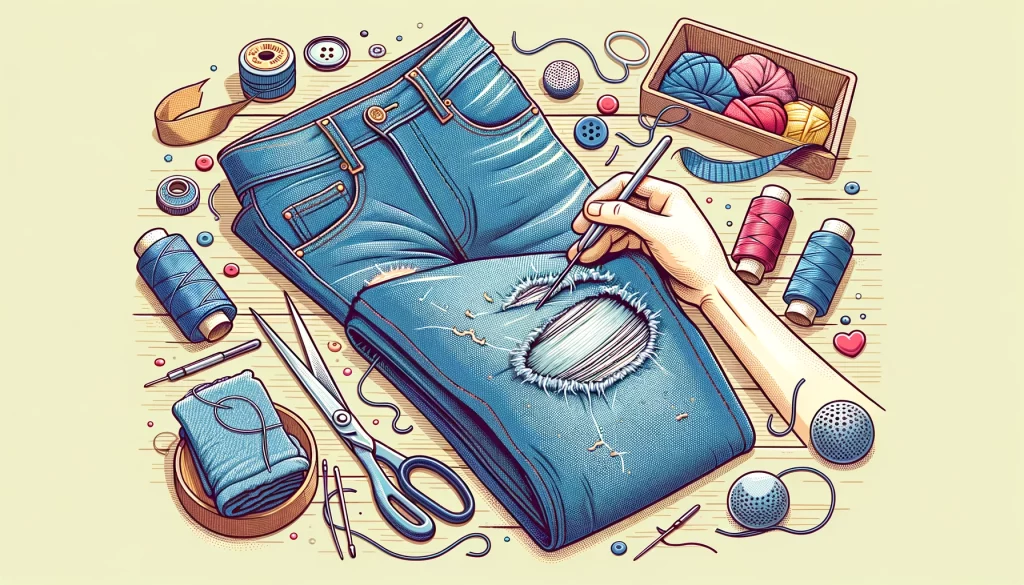
Have you ever found a favorite pair of jeans torn and thought it was the end for them? You’re not alone. Many of us face the disappointment of discovering rips in our most loved denim, unsure if they can ever be brought back to life. But there’s good news! Repairing ripped jeans is not only possible; it’s also a straightforward process that anyone can learn. Throughout this article, we’ll guide you through how to patch torn jeans. Showing various methods to mend those tears effectively, from simple sewing techniques to no-sew hacks that promise to restore your denim’s former glory easily.
Ready to give those jeans a second chance? Keep reading!
Key Takeaways
- Patching your jeans instead of throwing them away saves money and helps the planet by reducing waste.
- You can repair ripped denim using various methods like sewing with thread, darning with a sewing machine, using fabric mending tape, or applying iron-on patches for a no-sew option.
- Preparing your jeans properly before patching ensures a smoother repair process. This includes trimming frayed edges, washing and drying according to care instructions, and choosing materials that match your denim.
- Adding unique touches like decorative patches or embroidery stitches lets you personalize your repaired jeans and turn damage into fashion statements.
- Strengthening areas prone to wear and tear in your jeans prevents future tears, making them last longer and keeping them out of landfills.
Exploring the Different Methods to Fix Ripped Jeans
Discover a variety of techniques to bring your beloved denim back to life, from traditional sewing to innovative no-sew solutions. Dive into the world of DIY jean repair and find the perfect method that suits your skill level and style.
Sewing With Thread
Sewing with thread offers a straightforward method to mend ripped jeans, providing both durability and flexibility. For small holes, grabbing an embroidery needle and using at least four strands of white thread can create a sturdy repair that blends seamlessly with the denim’s fabric.
This technique not only fixes the tear but also adds a layer of reinforcement to prevent future damage.
Darning with a sewing machine introduces another efficient option for patching up denim. Employing a darning stitch enables quick coverage of larger areas, making it ideal for significant tears or thinning patches.
Tailoring ripped jeans with this method ensures longevity and restores the garment’s original look as much as possible. Whether stitching by hand or machine, selecting the right type of yarn—like embroidery thread for jeans repair—plays a crucial role in achieving professional-looking results that withstand regular wear and washing cycles.
Using Fabric Mending Tape
Fabric mending tape offers a quick fabric fix for those ripped jeans without the need for in-depth sewing skills. You simply place the tape under the damaged area and apply heat, usually with an iron.
This heat-activated patch bonds the fabric together, creating a durable repair that holds up well to wear and tear. It’s especially useful for reinforcing tears or adding extra durability to thinning areas of denim.
Combining this method with other repair techniques, such as sewing reinforcement or using interfacing, can provide a more robust solution to your denim repair needs. The ease of application makes fabric adhesive an excellent option for DIY clothing repair enthusiasts looking to extend the life of their favorite jeans.
Through careful application, individuals can effectively mend rips while maintaining the original look and feel of their denim garments.
Patching With Spare Fabric
Moving from the simplicity of fabric mending tape, patching with spare fabric introduces a creative and durable method to repair ripped denim. This approach allows for greater flexibility in covering larger tears or holes, providing a new lease on life for your favorite jeans.
Select a piece of spare fabric that closely matches or complements the color and texture of your denim. Cut it slightly larger than the tear to ensure full coverage.
To secure the patch effectively, place it behind the torn area and use a series of stitching techniques such as darning stitches or straight stitches around the edges. For added strength, interfacing can be applied beneath the fabric before sewing, creating an invisible bond that reinforces the repair.
This method not only fixes your jeans but also adds a unique touch, making each pair distinctly yours.
No-sew Options
Iron-on patches offer a quick and easy way to fix holes and tears in jeans without sewing. You simply place the patch over the damaged area, apply heat with an iron, and secure it in place.
This no-sew option provides a convenient solution for denim repair that anyone can do at home. It’s perfect for those who might not have sewing skills or equipment but still want to extend the life of their favorite jeans.
Using embroidery stitches to cover up holes adds a creative touch to jean repairs. Decorative clothing patches can also transform ripped denim into a unique piece of fashion without any need for needlework.
These methods not only fix tears but also allow you to personalize your jeans, making them stand out with custom designs. For straight tears, consider applying no-sew tear mender as an alternative method that bonds fabric together without stitching, providing both strength and flexibility to garment repairs.
Step-by-Step Guide to Repairing Ripped Denim
Follow our comprehensive guide to seamlessly patch up your favorite pair of jeans and breathe new life into them.
Preparing the Jeans
Preparing the jeans is a crucial first step in the process of repairing ripped denim. This phase sets the foundation for a successful mend, ensuring that your jeans are ready for a patch or stitch. Here’s how to do it:
- Start by laying the jeans flat on a sturdy surface. Make sure there are no wrinkles or folds, as this could affect your repair work.
- Carefully trim any frayed edges around the hole using sharp scissors. This creates a clean area to work with and helps prevent further unravelling.
- Reinforce areas prone to tearing, such as the crotch seam, by sewing around them or using fabric mending tape for additional support.
- Wash and dry the jeans according to their care label instructions before beginning any repair work. Clean fabric ensures that patches or stitches adhere properly and last longer.
- Create distressed patches if your style preference leans towards a more lived – in look. Doing this before attaching them helps integrate repairs seamlessly with the rest of your denim.
- Choose materials that closely match the color and weight of your denim for a discreet repair job. Picking matching threads or patches can make or break the final look of your repaired jeans.
Cutting Frayed Edges
After getting your jeans ready, the next step is tackling those troublesome frayed edges. Trimming these areas ensures a cleaner surface for patching and results in more durable repair work. Here’s how to effectively trim fraying threads and prepare the denim for patching:
- Lay the torn jeans flat on a work surface. Make sure the area around the hole is smooth and free from wrinkles to avoid uneven cuts.
- Identify all frayed edges and excess threads near the tear. These may contribute to further unraveling if not properly removed.
- Use sharp scissors for this job. Dull blades might pull on the denim fibers, causing more damage rather than helping.
- Carefully cut off frayed edges and excess threads, aiming for as close to the base of these imperfections as possible without cutting into more of the fabric than necessary.
- Check around and inside the hole for any hidden frays or loose threads that might have been missed during the initial inspection.
- Gently tug at the edge of the trimmed area to ensure no loosely attached threads are left behind. This step also helps reveal any spots that might need additional trimming.
- Keep your motions steady and controlled while cutting to avoid accidentally enlarging the hole in your jeans.
- Once all unwanted threads are removed, double-check your work to make sure you’ve achieved a clean-edged hole without any dangling or frayed threads remaining.
Choosing a Patch
Choosing the right patch is a critical step in repairing torn denim, setting the foundation for a durable and aesthetically pleasing repair. The options range from decorative patches to custom-cut fabric pieces, all of which serve to reinforce ripped jeans and restore their integrity.
- Consider the Material: Opt for a patch material that matches or complements your jeans. Denim patches work best for denim repairs since they offer similar wear and fade patterns over time.
- Size Matters: The patch should be slightly larger than the rip or hole you’re fixing. This extra margin ensures that you can securely attach it without stressing the damaged area further.
- Color Coordination: Matching the color of your patch with your jeans can make the repair less noticeable. For a bold statement, however, contrasting colors or patterns can turn the repair into a fashion highlight.
- Adhesive Options: Depending on your method, choose between iron-on patches, which provide an easy no-sew option, or patches without adhesive for sewing manually or with a machine.
- Shape Your Patch: Rectangular or square patches are easier to work with and attach. But don’t be afraid to cut shapes that follow the contours of your jeans or create a design element.
- Fabric Mending Glue: For an even stronger bond, especially around edges, consider using fabric mending glue alongside sewing or ironing. This reinforces the hold, making it ideal for areas prone to high stress.
Attaching the Patch
Attaching a patch to repair torn denim is a critical step in restoring your favorite jeans to their former glory. This process involves careful placement and sewing to ensure durability and a seamless look.
- Position the patch: Place the denim patch behind the torn area, making sure it covers the entire hole and has at least an inch of extra fabric around it for better support. Align it properly to maintain the jeans’ original lines and patterns.
- Secure with pins: Use straight pins to hold the patch in place from the front, ensuring it doesn’t shift while you’re sewing. Distribute pins evenly around the edge of the torn area for a secure hold.
- Choose your thread: Select a thread color that closely matches your jeans for a discreet repair, or go for a contrasting color if you prefer a decorative look. Thicker thread works best on denim material.
- Thread the needle: For hand stitching, use a sturdy needle designed for denim or heavy fabrics. Double up the thread for extra strength, but avoid making it too long to prevent tangling.
- Begin sewing: Start from the inside of the jeans to hide the knot of your thread. Use a simple running stitch or backstitch around the perimeter of the hole, roughly 1/8 to 1/4 inch from its edge, securing both layers of fabric together.
- Reinforce with stitches across: To ensure maximum hold, create X-shaped crosses over smaller holes or multiple parallel lines across larger areas within the boundaries of your initial stitching.
- Tie off securely: Once you’ve stitched all around and reinforced as needed, finish by tying off your thread on the interior side of your jeans with multiple knots to prevent unraveling.
- Trim excess fabric (optional): If there’s excess fabric from the patch protruding beyond your stitches after attaching, carefully trim it away without cutting too close to your threads.
Finishing touches
Giving your repaired denim jeans the right finishing touches can elevate their appearance and ensure durability. This step is all about attention to detail, from trimming frayed edges to adding decorative elements.
- Cut away frayed edges carefully around the tear or hole to prepare for a cleaner repair. This step prevents further unravelling and makes the area easier to work with.
- Sew up the rip using a method that matches the jeans’ original stitching style, if possible. A sewing machine offers precision, creating a secure and nearly invisible finish.
- Trim excess thread and any material that sticks out beyond the sewn area. This cleanup gives your repair work a polished look.
- For larger distressed areas, consider cutting out additional fabric patches to create unique distressed denim designs that add character to your jeans.
- Apply iron – on patches as an alternative for a quick fix, ensuring they firmly adhere to the fabric with proper heat application.
- Embellish the patched area with embroidery or extra stitches for a creative touch. This can turn your repair into an eye-catching design feature.
- Hand – stitch clean rips when preferring a more personalized approach, using techniques that enhance the garment’s handmade appeal.
Tips and Tricks for Successful Jeans Repair
Mastering the art of jean repair can transform your worn denim into stylish, durable wear; discover essential techniques for a seamless fix.
Matching thread color
Selecting the right thread color is crucial for a seamless jeans repair. You should aim to find a thread that closely matches your denim’s shade. This step ensures the repaired areas blend in with the original fabric, making the mend less noticeable.
For sewing machine repairs, threading your machine with a color that approximates that of your jeans maximizes the invisibility of stitches, particularly useful when applying an overcast stitch along torn edges.
Employing thread matching techniques enhances the overall appearance of your denim repair work. Whether you’re hand-sewing or using a sewing machine, choosing a thread in a matching color fortifies not only the strength but also maintains the aesthetic integrity of your jeans.
Effective denim repair relies on this attention to detail, ensuring mended areas are hardly discernible and extending the life of your favorite pair with successful jeans mending strategies.
Reinforcing areas prone to tearing
Reinforcing areas prone to tearing ensures your jeans can withstand more wear and tear, prolonging their life. One common area that often needs attention is the crotch, as it experiences a high amount of stress from movement and contains a significant amount of sweat and bacteria.
To strengthen denim in this critical zone, machine straight stitching across any holes multiple times creates a durable reinforced area. This method not only repairs existing damage but also prevents future tears.
Applying patches to areas like the knees or thighs offers another effective strategy for mending denim while adding an extra layer of fabric strength. Choose patches made from materials that match the weight and flexibility of your jeans to maintain comfort and mobility.
Sewing these patches on with a color-matched thread blends the repair seamlessly into the garment. These techniques ensure that fixing holes in jeans does more than just mend; they fortify vulnerable spots against new rips and snags.
Washing and drying considerations
Washing and drying jeans before starting any repair work is critical for ensuring the fabric is in its best condition. This step tightens up the cloth, making it easier to work with and helping the patch adhere more securely.
Always use cold water to prevent further shrinkage and damage to the denim. After washing, avoid twisting or wringing out your jeans as this can warp their shape.
Hanging ripped jeans to air out before storing them keeps them fresh and may prevent additional tearing. It’s advisable to dry your denim away from direct sunlight and heat sources, which could cause fading or weakening of the fabric.
Instead, opt for a well-ventilated area where air circulation can naturally do the job. This approach not only preserves the integrity of your repaired areas but also extends the overall life of your jeans, supporting sustainable clothing care practices.
Conclusion
Patching torn jeans doesn’t just breathe new life into your favorite denim; it also champions sustainability by reducing waste. This guide equips you with varied methods, from sewing to no-sew options, ensuring that anyone can tackle this DIY project.
Remember, repairing your denim strengthens not only the fabric but also your connection to cherished clothing items. Let’s embrace mending as a creative and environmentally responsible habit in our fashion choices.
FAQs
1. Can I patch torn jeans without sewing?
Yes, you can use iron-on patches or fabric glue as no-sew options to repair torn jeans.
2. What material works best for patching jeans?
Denim or thick cotton patches work best for durability and matching the look of your jeans.
3. How do I choose the right color patch for my jeans?
Try to match the patch material closely with your jean’s color or opt for a contrasting shade for a creative look.
4. Is it possible to make the patched area on my jeans less noticeable?
Using a patch from similar denim and carefully blending stitching can make repairs less noticeable.
5. Can all types of jean tears be patched effectively?
Most tears, especially in non-stretch areas like knees or thighs, can be effectively patched if addressed early.


